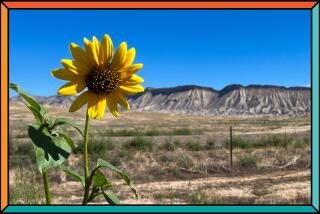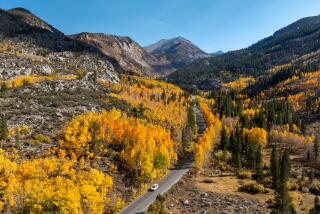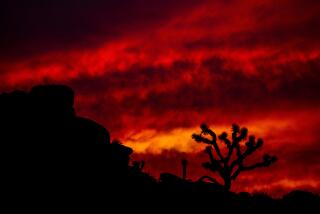California deserts will soon burst with wildflowers
The valleys and hillsides of the Southern California deserts have been preparing all winter for their close-up. Silent and forlorn, often harsh and austere, theyâre ready to shed their mantle of earth tones and dress themselves in wildflowers, thanks to the rain storms and subsequent warm days. Hereâs a look at whatâs unfolding in some of Southern Californiaâs best natural settings.
If you go
These five parks regularly update wildflower reports on their websites during viewing season. They also post activity calendars with details on ranger and docent programs. Desert USA, https://www.desertusa.com/wildflo/ca.html, keeps track of conditions throughout the Southwest deserts.
Anza-Borrego
Its lower desert elevation gives Anza-Borrego Desert State Park an early start on the wildflower viewing season. A decent winter rainfall nourished the ground sufficiently to help the seeds to germinate.
âIt should be crazy great,â says Michael Rodriques, the parkâs interpretive specialist. He predicts annuals will be at their peak until mid-March, with âhundreds of thousands of acresâ of desert sunflower, sand verbena and dune evening primrose around the Borrego Valley.
Brittlebush and other perennial shrubs will add a colorful note in rocky areas. The flattened pads of the beavertail cactus and the spindly stems of the ocotillo also are ready to burst.
âIt will be absolutely gorgeous,â Rodriques says. âThe aroma, youâll never forget.â
Anza-Borrego Desert State Park,
https://www.parks.ca.gov/?page_id=638
Joshua Tree
Joshua Tree National Park hedges its botanical bets with two ecological zones, making a staggered wildflower bloom possible. âPortions of the park have received up to 10 inches of rain since December,â says Joe Zarki, chief of interpretation. The bounty has stimulated early blooms in the lower eastern half of the park, where the whitish-yellow flowers of the small forget-me-nots compete for attention with chuparosa, a shrub covered with red tubular-shaped blossoms, and carpets of chia, a mint-family relative that Zarki describes as âweird-looking with spiky dark purple flower heads.â
In the higher Mojave desert, the parkâs namesake tree (actually not a tree but a member of the yucca genus) has just started to bud. âJoshua trees donât necessarily track with other wildflowers,â Zarki says. He expects wooly daisies, primroses and mariposa lilies as well as cacti to bloom in mid- to late March, with or without the Joshua trees.
Joshua Tree National Park,
https://www.nps.gov/jotr
Poppy Reserve
Milt Stark, vice president of the Poppy Reserve Mojave Desert Interpretive Assn., hesitates to quantify this yearâs seasonal display at the Antelope Valley California Poppy Reserve in Lancaster. âPredicting wild flowers is very difficult,â he says, recalling that âlast year looked great (in late winter), but it wasnât.â
It may not be until mid-April that gargantuan fields of orange poppies will blanket the parkâs rolling hills, with patches of blue lupine and purple owlâs clover making an appearance in riparian areas. The delay works out well for the preserve, which will be closed to vehicles (visitors may hike in) until March 1 because of state budget cuts. (The visitor center will not be open until the middle of the month.) The nearby Arthur B. Ripley Desert Woodland State Park is open. Expect to find California buckwheat, blue sage and other annuals among Joshua and some rare juniper trees.
Antelope Valley California Poppy Reserve,
https://www.parks.ca.gov/?page_id=627
Mojave
More optimism at the Mojave National Preserve. âWe have a biologist who lives in the Granite Mountains. He believes there will be very good blooms at lower elevations,â says Linda Slater, the parkâs chief of interpretation. In March, she expects evening primrose and sand verbena in the vicinity of the Kelso Dunes, desert marigold and Canterbury bell along Kelbaker Road and patches of beavertail cactus and Mojave Mound elsewhere in the vast park.
âIf we get another rain,â Slater says, âthe flower bloom will continue at higher elevations like the Mid Hills,â where globe mallow will paint the hillsides orange. The Joshua tree woodland on Cima Dome might sport creamy white blossoms, but Slater notes they do not bloom every year.
Mojave National Preserve, https://www.nps.gov/moja
Death Valley
Ranger Alan Van Valkenburg expects that by mid-March the tiny white sprouts he sees on the floor of Death Valley National Park will become the seasonâs first buds, ushering in a peak bloom later in the month. He says that near Furnace Creek the abundant yellow desert gold will turn the desert into, well, gold.
The purple notch-leaf phacelia will add a colorful counterpoint, one best enjoyed from a distance. âItâs a plant thatâs very beautiful, but donât touch it,â Van Valkenburg says. âIt can produce a rash much like poison oak.â
By the end of April, Van Valkenburg says temperatures will be too hot for most plants.
When the valley floor sizzles and wildflowers withdraw for the year, others come to life elsewhere. âIf things work out just right, the bloom might be getting to peak in higher elevations like Emigrant Canyon, Scottyâs Castle and Greenwater Valley,â Van Valkenburg says.
Death Valley National Park,
https://www.nps.gov/deva
More to Read
Sign up for The Wild
Weâll help you find the best places to hike, bike and run, as well as the perfect silent spots for meditation and yoga.
You may occasionally receive promotional content from the Los Angeles Times.






